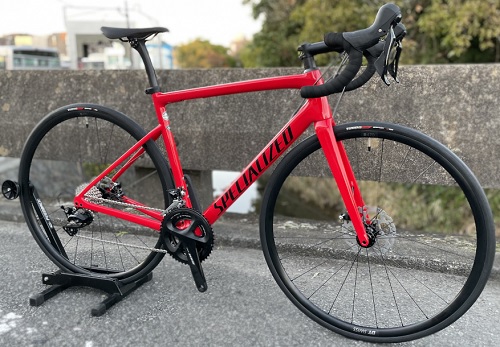
Specialized Tarmac SL6 guide to buying a used racing bike what to check for known and lesser-known defects prices which are the best vintages and which models to focus on
Buying Guide for a Used Specialized Tarmac SL6
The Specialized Tarmac SL6 is an iconic model in the world of road bikes, renowned for its balance between lightness, stiffness and aerodynamics. Buying a used example of this bike can represent a significant opportunity for cyclists of all levels. This technical guide delves into the crucial aspects to consider during the inspection, the known and lesser-known defects, market prices and the configurations to focus on for an informed purchase.
Introduction to the Specialized Tarmac SL6
Launched in 2017, the Specialized Tarmac SL6 marked a turning point for the brand, abandoning the concept of "rider-first engineered" of previous generations (SL4, SL5) for a more standardized approach but optimized for each size. This model was designed as an all-rounder capable of excelling both on climbs and on the flats, combining lightness and a good aerodynamic profile. It has been produced in several carbon variants:
Fact 9r: Base of the range, but still performing.
Fact 10r: Intermediate, a great compromise between weight and stiffness.
Fact 12r: Top of the range (used on the S-Works models), the lightest and stiffest.
The Tarmac SL6 was joined and then progressively replaced by the Tarmac SL7 starting in 2020. This makes the used market for the SL6 particularly interesting, with more affordable prices.
Key Things to Look for When Buying a Used Tarmac SL6
A thorough inspection of a carbon frame is essential to avoid future issues.
Visual Inspection of Frame and Paint:
Paint Quality: Tarmac SL6 paint, especially on the S-Works versions or with special finishes, can be delicate. Look for chips, peeling or bubbles that could indicate knocks or finish issues.
Stress Zones: Carefully examine high-stress areas such as the head tube, bottom bracket junction, seatstays (especially near the drive side dropout), and seat tube (especially the seat clamp area). Micro-cracks or “crazing” in these areas may suggest structural damage.
Impact Damage: Check the down tube and top tube for dents, deep scratches, or cracks. These are often indicators of significant crashes or impacts. The “touch test” (lightly tapping a coin on the surface of the carbon) may reveal a change in sound (from crisp to dull) indicating potential internal delamination.
Carbon Structural Integrity:
Dropouts: Check the integrity of the dropouts, both front and rear, to ensure they are not bent or damaged due to crashes or over-tightening of the thru-axle.
Fork Steerer: Inspect the fork steerer tube (inside the head tube) for signs of wear, cracks, or excessive tightening by the stem.
Cable Routing: The Tarmac SL6 has semi-integrated cable routing. Make sure the cables run freely and that there is no internal chafing that can damage the carbon.
Bottom Bracket (OSBB):
Noise: The Tarmac SL6 uses the OSBB (OverSized Bottom Bracket) standard, a variation of Specialized's PressFit 30. This standard can be prone to creaking if the bottom bracket is not installed properly or if the bearings are worn/contaminated. Ask the seller to ride under load to listen for any noise.
Inspection: Visually check the bottom bracket area for cracks or signs of abnormal flex.
Headset:
Play: With the front wheel braked, rock the bike back and forth to check for play in the headset.
Smoothness: Rotate the handlebars from side to side to ensure smooth rotation without sticking, indicating good bearings.
Components and General Wear:
Drivetrain: Assess the wear of the chain, cassette and chainrings. Sharp or “shark” teeth indicate a worn drivetrain that will require expensive replacement.
Brakes: For disc versions, check the thickness of the pads and the integrity of the rotors (no excessive warping or scoring). For rim versions, check the wear of the pads and rim. Check the functionality of the levers and for fluid leaks for disc brakes.
Wheels: Inspect the rims for dents, cracks or signs of impact. Check the tension and integrity of the spokes and the smooth rotation of the hubs, checking for play.
Seatpost and Saddle: The seatpost is proprietary. Check for deep scratches or signs of over-tightening that could compromise the carbon.
Known and Lesser Known Flaws of the Specialized Tarmac SL6
Known Flaws (mainly on early or used builds): Bottom Bracket (OSBB) Creaks: As mentioned, the OSBB system is notorious for its sensitivity to installation. Creaks are often fixable with proper reinstallation and the use of specific compounds, but they can be annoying. They are not necessarily a structural defect of the frame, but an interface issue.
Soft Paint: Some paint jobs, especially metallic or matte finishes, can be more susceptible to chipping and scratching. This is more of an aesthetic issue than a functional one.
Lesser-Known Flaws / Common Issues with All High-End Carbon Frames:
Hidden Crash Damage: Carbon is strong but not indestructible. A significant crash can cause internal delamination that is not externally visible. Buying from a reputable seller and asking for a complete history of the bike is crucial.
Over-Tightening Components: Over-tightening components such as the seatpost clamp, stem, or seat clamp can damage the carbon. Look for signs of crushing or cracking in these areas. Always use a torque wrench.
Fork Steerer Wear: If the bike has been ridden with a misaligned stem or improperly adjusted headset, the fork’s carbon steerer may experience wear or compression.
Market Value and Influencing Factors
Prices for a used Specialized Tarmac SL6 vary widely, typically between $1,500 and $4,500, depending on a variety of factors:
Overall Condition: The most important factor. A flawless, well-maintained frame will hold a higher value.
Vintage: Newer vintages (2019-2020) are generally more expensive than earlier vintages (2017-2018).
Carbon Version (Fact 9r/10r/12r): S-Works models (Fact 12r) hold the highest value.
Build (Groupset & Wheels):
Electronic Groupset: An electronic groupset (Shimano Ultegra Di2, Dura-Ace Di2, SRAM Force eTap AXS, Red eTap AXS) will significantly increase the price.
Carbon Wheels: Lightweight, aerodynamic carbon wheels (Roval, Zipp, Enve, Campagnolo, Fulcrum) are a big plus.
Brakes: Disc brake models are generally more sought after and hold a higher value than rim brake versions.
Mileage & History: Bikes with low mileage and a clear history (purchase invoice, documented maintenance) are more valuable.
Color/Special Editions: Some colorways or limited editions may command a slight premium for collectors.
Best Vintages & Models to Look Out For
There is no absolute “best” vintage, as the SL6 has been a mature model since its launch. However, there are a few considerations:
More Recent Vintages (2019-2020): These are often preferable because they tend to have the latest revisions and less overall wear. Additionally, most models from these vintages are already equipped with disc brakes, the preferred choice in the current market.
Models to Look For:
S-Works Tarmac SL6 Disc: This represents the top of the range for performance and lightness (Fact 12r frame). Combined with an electronic groupset and carbon wheels, it is an extremely high-performance bike.
Tarmac SL6 Expert/Pro Disc: They offer excellent value for money. The Fact 10r frame is only marginally heavier than the 12r, and they often come equipped with Shimano Ultegra Di2 or SRAM Force AXS groupsets and Roval carbon wheels, making them complete and competitive bikes without the added cost of the S-Works.
Conclusion
Buying a used Specialized Tarmac SL6 can be a great move for those looking for a versatile, high-performance road bike. The key is a thorough inspection of the frame for structural damage to the carbon and an honest assessment of component wear. By focusing on disc brake models with quality specs, you can find a bike that offers an excellent balance between price and performance. Always consider the bike's history and, if possible, have it checked out by a trusted mechanic before making a final purchase.
